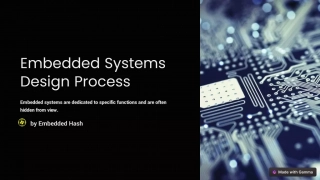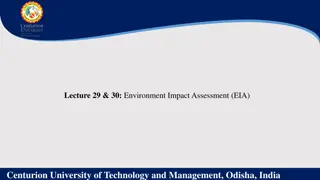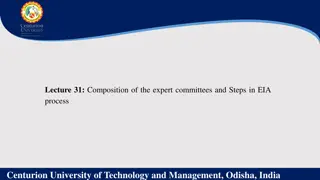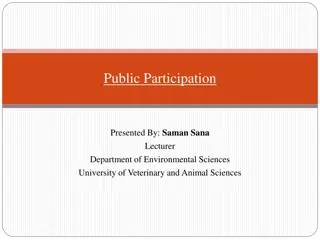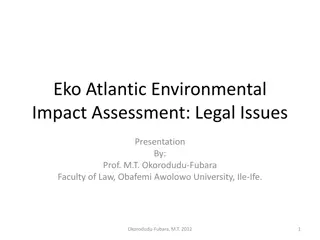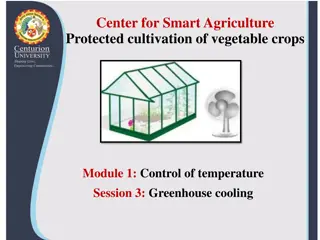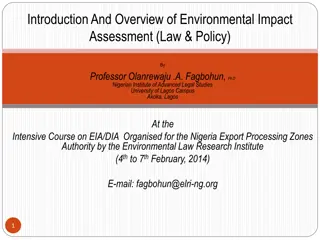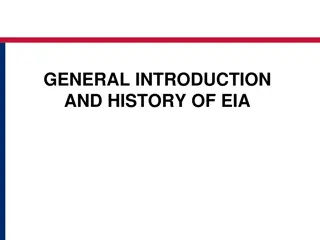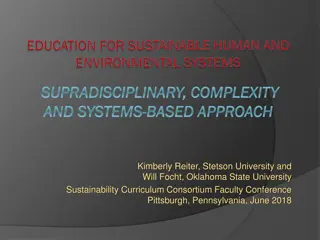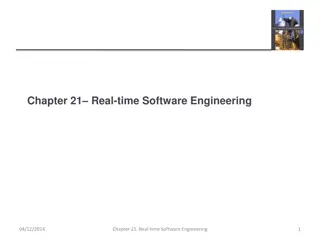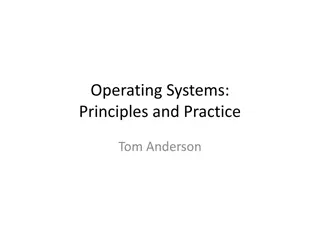Enhancing Food Systems for Improved Food Security and Job Creation
The importance of improving food systems to achieve sustainable development goals and enhance food security and job creation. It covers topics such as the current food systems, the impact of these systems, jobs in the food systems value chain, and key recommendations.
8 views • 24 slides
Annual Energy Outlook 2023
The U.S. Energy Information Administration (EIA) releases the Annual Energy Outlook 2023 with projections to 2050, exploring long-term energy trends in the United States. The report includes different cases with varying assumptions, such as economic growth, oil prices, and zero-carbon technology cos
2 views • 25 slides
Understanding Multimedia Systems: Hardware and Software Components
Multimedia systems require specific hardware and software components to meet the demands of producing and playing multimedia content. Development systems are used for creating content with higher specifications, while playback systems are used for playing multimedia files with lower specifications.
8 views • 46 slides
Environmental Workshop Overview: Ministry of Environment in the Solomon Islands
The Environment and Conservation Division (ECD) of the Ministry of Environment, Climate Change, Disaster Management, and Meteorology in the Solomon Islands focuses on sustainable environmental management, conservation, and protection of natural resources. The ECD's vision is to safeguard the environ
1 views • 15 slides
Embedded Systems Design Process in the Embedded systems
Embedded systems are all around us, from the tiny microcontrollers in our household appliances to the sophisticated control systems in cars and aeroplanes. But how are these systems designed? Let's delve into the basics of the embedded systems design process in simple terms that anyone can understan
2 views • 9 slides
Overview of Distributed Systems: Characteristics, Classification, Computation, Communication, and Fault Models
Characterizing Distributed Systems: Multiple autonomous computers with CPUs, memory, storage, and I/O paths, interconnected geographically, shared state, global invariants. Classifying Distributed Systems: Based on synchrony, communication medium, fault models like crash and Byzantine failures. Comp
9 views • 126 slides
Operating Systems
An operating system is a crucial program that manages all other programs on a computer. It handles tasks like input recognition, file management, and device control. There are different types of operating systems such as single-user, single-task systems, multi-user, multi-task systems, real-time ope
6 views • 11 slides
Understanding Information Systems in Organizational Management
Management in organizations is divided into three levels: operational, tactical, and strategic. Each level requires different information systems to support various activities. Operational systems focus on routine transactions and control processes, while middle-level systems aid in semi-structured
8 views • 39 slides
Understanding Negative Results in Systems Research
Systems research encompasses various areas such as operating systems, networking, and distributed systems. Negative results in systems research often go unpublished, leading researchers to focus on curating positive outcomes. This practice can hinder the credibility of scientific findings and impede
5 views • 23 slides
Explore the Top 5 Trends in Alarm Systems with Shellharbour Security Systems
Explore the latest trends in alarm systems with Shellharbour Security Systems. Learn about advancements such as smart home integration, wireless technology, AI-powered monitoring, and more. Stay informed to enhance your home or business security with cutting-edge solutions. Visit: \/\/shellharbourse
7 views • 8 slides
Understanding Management Information Systems (MIS)
Management Information Systems (MIS) are vital for collecting, processing, and analyzing data in business activities. They assist decision makers, facilitate communication, and maintain records. Components include people, data, business procedures, hardware, and software. Various types of informatio
1 views • 11 slides
Environmental Impact Assessment (EIA) Evolution and Importance at Centurion University
The Environmental Impact Assessment (EIA) process evaluates the environmental impacts of proposed projects, aiming to minimize adverse effects. Originating in the 1970s, EIA has evolved globally, becoming a key policy tool for sustainable development. In India, EIA began in 1976-77 and was later mad
0 views • 4 slides
Steps in the EIA Process at Centurion University, Odisha, India
The Environmental Impact Assessment (EIA) process at Centurion University involves crucial steps such as screening, scoping, baseline data collection, impact prediction, mitigation measures, public hearing, decision making, and monitoring. It is a cyclical process that requires thorough assessment o
0 views • 4 slides
Enhancing Environmental Impact Assessment Through Public Participation
Public involvement in the Environmental Impact Assessment (EIA) process is crucial for obtaining valuable insights, reducing conflicts, and improving decision-making transparency. This involvement aims to inform stakeholders, consider alternatives, and maximize benefits while addressing concerns. Ke
0 views • 28 slides
Eko Atlantic Environmental Impact Assessment and Legal Issues Presentation
Prof. M.T. Okorodudu-Fubara from Obafemi Awolowo University presents on the Eko Atlantic Environmental Impact Assessment, focusing on legal requirements, the EIA process, preemptive measures, violations, and vital laws applicable to the project. The presentation outlines the planned project to dredg
0 views • 20 slides
Introduction to Database Management System Explained
This presentation covers the basics of database management systems, including definitions of data, types of data, structured and unstructured data, storing data in computers using file systems and database systems, and issues with file systems like data redundancy, inconsistency, difficult data acce
1 views • 18 slides
Understanding Different Types of Recommender Systems
Recommender systems play a crucial role in providing personalized recommendations to users. This article delves into various types of recommender systems including Collaborative Filtering, Content-Based, Knowledge-Based, and Group Recommender Systems. Collaborative Filtering involves making predicti
0 views • 7 slides
Efficient Greenhouse Cooling Systems for Smart Agriculture
Active summer cooling systems like fan-and-pad and fog systems are crucial for maintaining optimal temperatures in greenhouses. These systems work by utilizing evaporation to remove heat from the air. Fan-and-pad cooling systems have been in use since 1954, where water is passed through pads to cool
1 views • 23 slides
Environmental Impact Assessment: Concepts, Principles, and Applications
This presentation by Professor Olanrewaju A. Fagbohun provides an in-depth overview of Environmental Impact Assessment (EIA) and Development Impact Assessment (DIA), highlighting their roles in environmental management and planning. The clarification of concepts such as EIA and DIA, along with guidi
0 views • 26 slides
Understanding Emergency Communication Systems for Volunteer Training
This content covers various topics related to emergency communication systems for volunteer training, including agency communication systems, government radio systems for police and fire departments, emergency medical radio systems, American Red Cross frequencies, and types of served-agency radio sy
2 views • 29 slides
Introduction to Embedded Systems Design
Embedded Systems Design, Chapter 1 provides an insightful overview of embedded systems, distinguishing them from general-purpose computers. The chapter delves into the characteristics of embedded systems, their design considerations, and the various types of embedded computers such as general-purpos
1 views • 7 slides
Comprehensive Environmental Impact Assessment Checklist
This comprehensive checklist provides guidance on gathering baseline data across key categories for Environmental Impact Assessments (EIA). It covers aspects like air quality, climate, ecology, biodiversity, and the human environment, offering detailed descriptions for each category.
0 views • 9 slides
Evolution of Environmental Impact Assessment (EIA) and its Significance
EIA began in response to environmental crises in the 1960s due to population growth, industrialization, and urbanization. Developing countries also face severe environmental challenges, necessitating EIA adoption. The history and reasons for EIA implementation are outlined, emphasizing the global im
2 views • 49 slides
Enhancing EIA Systems: Role of International Communities
This detailed report discusses the importance of international communities in strengthening Environmental Impact Assessment (EIA) systems. It covers key review areas, criteria, stakeholder participation, and the quality of predicted impacts and mitigation measures. Recommendations are provided for i
1 views • 12 slides
Understanding Impact Analysis in Environmental Sciences
Impact analysis, presented by Saman Sana, explores the importance of identifying and evaluating environmental changes resulting from project implementation. The Environmental Impact Assessment (EIA) process involves screening, scoping, impact analysis, and prediction phases to forecast and evaluate
0 views • 36 slides
Transboundary Environmental Impact Assessment for Greenstar Development
The Transboundary Environmental Impact Assessment (EIA) conducted for the Greenstar Development project involving EU Member States A and B reveals potential environmental impacts like soil and waste deposition, polluted dredging material transfer, and altered currents affecting wetlands and flooding
0 views • 7 slides
Texas Oil & Gas Association Mineral Sub-Committee Annual Property Tax Conference
The Texas Oil & Gas Association Mineral Sub-Committee is organizing its Annual Property Tax Conference on March 7-8, 2024. The committee members will discuss valuation parameters, Circuit Breaker Legislation, and meet with Appraisal Firms to summarize discussions. They will also review Texas Product
0 views • 25 slides
Management of C. difficile Infection Testing and Treatment Protocol
Stony Brook has implemented a two-step testing algorithm for C. difficile infection using PCR and EIA tests to differentiate between active infection and asymptomatic carriage. Positive PCR results are further tested with EIA. The protocol includes criteria for CDI testing, specimen collection guide
0 views • 5 slides
Understanding Marine Phosphate Mining in Namibia: EIA Process, Findings, and Decision-Making
Explore the complexities surrounding marine phosphate mining in Namibia, focusing on the Environmental Impact Assessment (EIA) process, key findings, and the challenges in reaching a sound decision. Delve into the global overview of seabed mining, the significance of EIA, and the broader recommendat
0 views • 32 slides
Clean Fuels Forecast Review - August 22nd, 2023 Summary
Reviewed in this forecast are the Committee's discussions on major policy changes and proposals, including Advanced Clean Cars I & II, Clean Trucks Plan/Rules, Bipartisan Infrastructure Law, Inflation Reduction Act, Washington Clean Fuel Standard, and Portland Renewable Fuel Standard. The Oregon Dep
0 views • 29 slides
Overview of Environmental Impact Assessment and Strategic Environmental Assessment Directives
Environmental Impact Assessment (EIA) and Strategic Environmental Assessment (SEA) play crucial roles in evaluating the impact of planned activities on the environment. This content delves into the concept, origins, development, and key elements of environmental assessment, discussing the legal fram
2 views • 35 slides
Information Systems in Organizations: Overview and Implementation
Information systems play a crucial role in organizations, encompassing transaction processing systems, functional area information systems, and enterprise resource planning systems. This content delves into the purpose of transaction processing systems, the support provided by information systems ac
0 views • 30 slides
Understanding NMEA Protocol in Maritime Technology
The NMEA Protocol, defined by the National Marine Electronics Association (NMEA), sets standards for communication among marine instrumentation. NMEA 0183, a key standard, establishes electrical interfaces in marine electronics. Additionally, NMEA 2000 introduces a new standard for shipboard electro
1 views • 15 slides
Understanding Cascade Control Systems in Industrial Processes
Cascade control systems play a crucial role in improving process control efficiency by incorporating feedback loops within feedback loops. This type of control architecture helps to better handle disturbances and variations in the process by creating secondary loops that monitor specific parameters.
0 views • 8 slides
Sustainable Education for Human and Environmental Systems
Sustainable Education for Human and Environmental Systems (SHES) focuses on fostering sustainable societies through social learning and systems thinking. It aims to promote interconnectedness between human and environmental systems, with a vision of enhancing well-being while maintaining the viabili
0 views • 19 slides
Ethics in Engineering Practice: Staying Within Your Limits
Environmental Impact Assessment (EIA) specialist engineer approached for a project exceeding his competency level. While competent in most aspects, the engineer lacks expertise in traffic impact assessment. He must decide whether to proceed personally or recommend hiring a specialist, balancing ethi
0 views • 47 slides
Key Aspects of Environmental Impact Assessment (EIA) Review Process
The Environmental Impact Assessment (EIA) review process plays a crucial role in evaluating the environmental, social, and economic impacts of proposed projects. It involves assessing the adequacy of reports, ensuring stakeholder involvement, and verifying the sufficiency of information for decision
0 views • 29 slides
Understanding Embedded Systems and Cyber-Physical Systems
Embedded systems are specialized computer systems embedded within larger systems, such as control systems and car controllers. This lecture covers real-time aspects, applications of Cyber-Physical Systems (CPS), and examples like the Boeing 777/Airbus A380 cockpit. It discusses the design process of
0 views • 22 slides
Understanding Real-time Software Engineering for Embedded Systems
Embedded systems play a crucial role in controlling various machines and processes. Real-time software engineering focuses on designing systems that respond instantly to events, ensuring correctness and timeliness. Characteristics like continuous operation, unpredictable environment interactions, an
0 views • 59 slides
Understanding Operating Systems: Principles and Practice in CSE Curriculum
Dive into the world of operating systems through the lens of "Operating Systems: Principles and Practice" by Tom Anderson. Discover how this course fits in the UW CSE curriculum, covering systems programming, operating system interfaces, and distributed systems. Explore the project work on building
0 views • 21 slides




